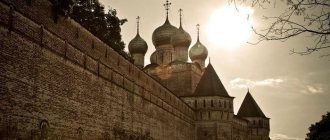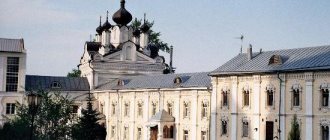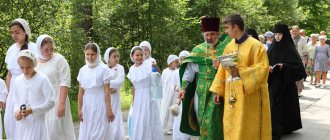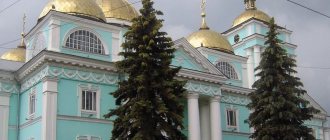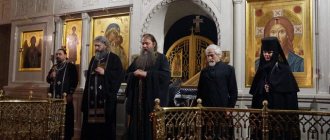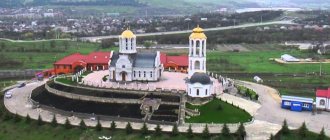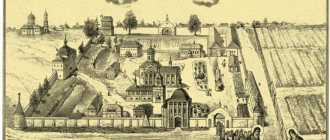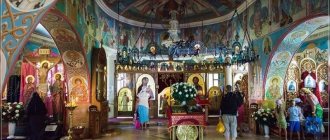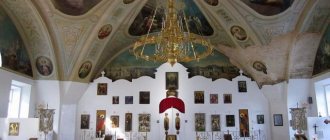Mir
Russia Yaroslavl region Solba town Nikolo-Solbinsky convent The map is loading…
{"format":"leaflet","minzoom":false,"maxzoom":false,"limit":50,"offset":0,"link":"all","sort":[""], "order":[],"headers":"show","mainlabel":"","intro":"","outro":"","searchlabel":"\u2026 \u0441\u043b\u0435\ u0434\u0443\u044e\u0449\u0438\u0435 \u0440\u0435\u0437\u0443\u043b\u044c\u0442\u0430\u0442\u044b","default":"","import-annotation":false,"width ":"auto","height":"350px","centre":{"text":"","title":"""link":"""lat":56.997940999999997302438714541494846343994140625,"lon": 38.4159810000000021545929485000669956207275390625,"icon":""},"title":"","label":"","icon":"","lines":[],"polygons":[],"circles":[ ],"rectangles":[],"copycoords":false,"static":false,"zoom":8,"defzoom":14,"layers":["OpenStreetMap"],"image layers":[] ,"overlays":[],"resizable":false,"fullscreen":true,"scrollwheelzoom":true,"cluster":false,"clustermaxzoom":9,"clusterzoomonclick":true,"clustermaxradius":80, "clusterspiderfy":true,"geojson":"","clicktarget":"","showtitle":true,"hidenamespace":false,"template":"","userparam":"","activeicon": "","pagelabel":false,"ajaxcoordproperty":"","ajaxquery":"","locations":[{"text":"\u003Cb\u003E\u003Ca href=\"/palomnik/%D0% 9D%D0%B8%D0%BA%D0%BE%D0%BB%D0%BE-%D0%A1%D0%BE%D0%BB%D1%8C%D0%B1%D0%B8%D0%BD %D1%81%D0%BA%D0%B8%D0%B9_%D0%B6%D0%B5%D0%BD%D1%81%D0%BA%D0%B8%D0%B9_%D0%BC%D0 %BE%D0%BD%D0%B0%D1%81%D1%82%D1%8B%D1%80%D1%8C\" title=\"\u041d\u0438\u043a\u043e\u043b\u043e-\ u0421\u043e\u043b\u044c\u0431\u0438\u043d\u0441\u043a\u0438\u0439 \u0436\u0435\u043d\u0441\u043a\u0438\u0439 \u043c\u043e\u0 43d\u0430\u0441\u0442\u044b\ u0440\u044c\»\u003E\u041d\u0438\u043a\u043e\u043b\u043e-\u0421\u043e\u043b\u044c\u0431\u0438\u043d\u0441\u043a\u0438\u0439\ u0436\u0435\u043d\u0441 href =\"/palomnik/ %D0%A1%D0%B2%D0%BE%D0%B9%D1%81%D1%82%D0%B2%D0%BE:%D0%90%D0%BD%D0%BD%D0%BE% D1%82%D0%B0%D1%86%D0%B8%D1%8F\" title=\"\u0421\u0432\u043e\u0439\u0441\u0442\u0432\u043e:\u0410\u043d\u043d\u043e \u0442\u0430\u0446\u0438\u044f\»\u003E\u0410\u043d\u043d\u043e\u0442\u0430\u0446\u0438\u044f\u003C/a\u003E: \u0420\u0430\u0 441\u043f\u043e\ u043b\u043e\u0436\u0435\u043d \u043d\u0430 \u0440\u0435\u043a\u0435 \u0421\u043e\u043b\u044c\u0431\u0430 \u0432 \u043c\u0435 \u0441\u0442\u0435\u0447\u043a\ u0435 \u0421\u043e\u043b\u044c\u0431\u0430 \u041d\u0430\u0433\u043e\u0440\u044c\u0435\u0432\u0441\u043a\u043e\u0433\u043e \u 0441\u0435\u043b\u044c\u0441\ u043a\u043e\u0433\u043e \u043f\u043e\u0441\u0435\u043b\u0435\u043d\u0438\u044f \u041f\u0435\u0440\u0435\u0441\u043b\u0430\u0 432\u0441\u043a\u043e\u0433\ u043e \u0440\u0430\u0439\u043e\u043d\u0430 \u042f\u0440\u043e\u0441\u043b\u0430\u0432\u0441\u043a\u043e\u0439 \u043e\u0431\u 043b\u0430\u0441\u0442\u0438\ u0432 95 \u043a\u043c \u043e\u0442 \u0421\u0435\u0440\u0433\u0438\u0435\u0432\u0430 \u041f\u043e\u0441\u0430\u0434\u0430. \u041f\u0440\u0438 \u043c\u043e\u043d\u0430\u0441\u0442\u044b\u0440\u0435 \u0434\u0435\u0439\u0441\u0442\u0432\u0443\u0435\ u0442\u0433\u043e\u0441\u0442 \u0438\u043d\u0438\u0446\u0430.","title":"\u041d\u0438\u043a\u043e\u043b\u043e-\u0421\u043e\u043b\u044c\u0431\u0438\u043d\u0441\ u043a\ u0438\u0439 \u0436\u0435\u043d\u0441\u043a\u0438\u0439 \u043c\u043e\u043d\u0430\u0441\u0442\u044b\u0440\u044c","link":"","lat":56.9 97940999999997302438714541494846343994140625, "lon":38.4159810000000021545929485000669956207275390625,"icon":""}],"imageLayers":[]}
56.997098; 38.418834
Russia, Yaroslavl region, Pereslavl-Zalessky urban district, Solba town
Solba town, Yaroslavl region
Russia
Telephone
: 8-915-970-24-74 (monastery); 8-915-970-43-28 (hotel).
(secretary of the monastery); [email protected] (monastery visit, hotel)
Nikolo-Solbinsky Monastery
- female (until 1904 - male) monastery of the Yaroslavl diocese of the Russian Orthodox Church. Located on the Solba River in the town of Solba, Nagoryevsky rural settlement, Pereslavl district, Yaroslavl region, 95 km from Sergiev Posad. There is a hotel at the monastery.
History[edit]
The Nikolo-Solbinsky Convent is located on the banks of the winding quiet Solba River, on the highway connecting the Trinity-Sergius Lavra, Pereslavl-Zalessky and Uglich.
The founding of the original men's Nikolaev hermitage dates back to the 15th century. It received its name from the main shrine of the monastery - the miraculous icon of St. Nicholas, which miraculously appeared at this place and was carefully preserved until the 20th century, as well as from its deserted location.
It is known from ancient scribe books that already by the middle of the 16th century the hermitage had large lands, and in the monastery itself there was a wooden church in honor of St. Nicholas with the side-chapel of the Great Martyr. Barbarians. The peaceful existence of a small brethren, however, able to provide for themselves in all necessary needs, continued until the beginning of the 17th century, until troubled times. During the interregnum, the monastery was completely destroyed by the Poles and robbers. For about 100 years, the Solbinsk monastery was desolate, and all its lands were given away as rent.
In 1711, at the request of Archimandrite Varlaam of the Danilovsky Monastery, with the permission of Peter I, the monastery began to be restored. Through the efforts of Archimandrite Varlaam, a new, now stone church was built in honor of the Dormition of the Mother of God with warm chapels of the Beheading of John the Baptist and the Intercession of the Most Holy Theotokos. But only by the middle of the 17th century, at the request of the brethren, by decree of the Holy Synod, the deserts, which had previously been given as rent to the monastery, acquired independence.
In 1840, the monastery was surrounded by a stone fence with 8 towers.
On the territory of the monastery there was a holy well in honor of St. Nicholas of great healing power, so the brethren were allowed to take his holy water only on the twelve holidays.
The monastery maintained a strict charter. Despite the small number of inhabitants, two liturgies were served daily, and agricultural work was carried out manually in the fields, barnyard, and 2 mills.
History has not preserved the reasons for the decline of the monastery. By the beginning of the 20th century, the monastery was left without a rector for a long time. The chronicle says that the small brotherhood was not able to run the household and maintain the monastery, so in 1903 the Holy Synod adopted a radical measure to rename the Nikolo-Solbinsk hermitage from men's to women's.
In the same year, several sisters arrived at the monastery with the newly appointed abbess Macaria from the Pereslavl St. Nicholas Monastery. Skillful housekeeping and the hard work of the sisters led to the true flourishing of the monastery. This is also evidenced by the rapid growth in the number of nuns: by 1914 there were 115 sisters.
First of all, the church was renovated inside and out (the warm chapels were consecrated in honor of the Intercession of the Mother of God and St. John the Baptist), new residential buildings, a stable and all the necessary utility rooms were built.
The sisters worked not only on the land, but also did handicrafts - sewing, embroidery, reading spiritual books (the monastery had a small library).
The icon of St. was still sacredly revered. Nicholas. Three copies were made from it, which were used to surround the surrounding villages and fields. Frequent prayer services were served before the original, at the request of pious local residents.
In a short time, the monastery became so strong that it was able to provide all possible charitable assistance: during the First World War, the sisters sewed underwear and sheepskin coats for Russian army soldiers.
The history of the Nikolo-Solbinsky convent was interrupted in November 1918 after its abolition and the formation of the New Life agricultural commune in its place. For some time the monastery did not exist for long. Abbess Macaria and some sisters were discovered and arrested. Their further fate remains unknown.
In the meantime, the monastery was turned into a parish, and then completely closed. According to the state plan to combat the remnants of the past - religion, in 1937 Hieromonk Paisiy and priest Leonid Gilyarevsky, who served in the monastery, were arrested and shot. Over the course of three years, members of the commune squandered all the wealth of the monastery and dismantled many of the buildings.
During the Great Patriotic War, an orphanage was located here, and later a mental hospital. The Assumption Church was used as a dining room and club. A stoker was built in the left aisle. The interior space of the temple was completely distorted by partitions. All the windows of the temple and building were covered with bars. In the 60s, the unique walls with towers were dismantled for the construction of roads.
When in 1994 the ancient desecrated shrine returned to the fold of the Church, its revival seemed impossible. All buildings and communications needed major reconstruction.
Only in January 1999, with the blessing of His Eminence Bishop Micah, three nuns arrived at the new place with the Mother Superior, nun Erotiida. With God's help, under the patronage of St. Nicholas, with the warm participation of good people, the revival of the monastery began.
Currently, the Assumption Church with chapels in honor of St. has been restored inside and outside. Nicholas (when the main church of the monastery in honor of St. Nicholas passed away, the Predtechensky chapel of the Assumption Church was renamed Nikolsky) and the Intercession of the Mother of God, which was consecrated by Bishop Joseph of Uglich, vicar of the Yaroslavl Diocese on the day of the Intercession of the Most Holy Theotokos in 2001. At the same time, a major overhaul of the nursing building was carried out.
The mystery of the origin
It is not known for certain when the monastery was founded. The first record found about her in chronicles dates back to 1544. By this time, the monastery was rich in land, judging by the description of the property. The establishment of the monastery can be dated back to the middle of the 15th century. Initially the monastery was for men. Who its founder was is also unknown. Researchers and current nuns believe that the monastery was opened by a disciple of the Venerable Wonderworker Sergius of Radonezh. This is also indicated by the geographical location: the Nikolo-Solbinsky convent is located in the north-east direction from Moscow. As is known, almost all the monasteries in this part of the region were founded by the followers of Sergius of Radonezh.
This connection is also indicated by two icons that were previously located on the gate. On one side the entrance was consecrated by the image of St. Nicholas, and on the other by St. Sergius. The first monastery was located a few kilometers from the modern location: in the Byltsyn field, surrounded by forests. Currently, the sisters have installed a worship cross at this place. The modern monastery - Nikolo-Solbinsky - was built on the banks of the Solba River. The name in the ancient Finno-Ugric language means “living water”.
Current state[edit]
The main direction in the sisters' obedience is needlework, as well as maintaining order in the household - in the kitchen, in the garden, in the barn. Currently, there are 15 nuns working in the monastery.
Despite the fact that the monastery is located in the middle of a forest, on major holidays many guests and parishioners from nearby villages gather, who have no place to accommodate them during meals. The question of building a new building became acute. And it was unexpectedly decided. With God's help and with the assistance of benefactors - the construction of a superstructure over the sister building - a refectory church in honor of Blessed Xenia of St. Petersburg.
Restoration work in the monastery has just begun. All other necessary buildings are waiting in the wings and their benefactors. According to the master plan, in the future it is planned to build bishop's chambers, a medical center with a temple in honor of the Great Martyr. Barbarians, since in the district there is no opportunity to provide medical care to the local population, pilgrims and sisters, therefore the monastery will gladly accept specialists with medical education as nuns. Also, everyone who would like to serve God through their profession - teachers, musicians, artists, icon painters, carvers, will be able to find their place in our monastery, realizing their God-given abilities and professional skills.
There is a shelter for girls at the monastery.
Revival and life of the sisters
In 1994, the Yaroslavl diocese again received the Solbinsk monastery. Looking at the sad remains of the once prosperous monastery, it was difficult to believe even in the simple possibility of a revival of spiritual life. Initially, the monastery was assigned to the Nikitsky Pereslavl Monastery. There were no permanent residents or abbot here, no work was carried out. Subsequently, it was decided to build a convent on this site, but none of the nuns stayed - it was very difficult to live in a place where homeless people and alcoholics huddled in ruins.
In January 1996, the monastery received abbess Erotiida and three novices, who managed to breathe new life into the holy place. Now the monastery is rapidly becoming prettier, regaining its former grandeur and has already been revived as a shelter for girls. Several social programs aimed at supporting older, infirm people have been launched and developed. In addition, assistance has been provided to low-income and large families. An educational program has also started.
Temples[edit]
- Temple in honor of St. Nicholas the Wonderworker, view of the entrance to the monastery
- Church of Peter and Paul
- A temple under construction in honor of the Great Martyr Barbara
- Temple in honor of St. Sergius of Radonezh and underground temple in honor of Anthony and Theodosius of Kiev-Pechersk
- Temple in honor of Blessed Xenia of Petersburg
- Assumption Church, view of the altar
- Temple in honor of St. Spyridon of Trimythos
The impossible is possible!
Construction is underway on the territory of the monastery. 4 churches were erected and consecrated. Several more churches are being built, each with unique architecture and decoration. During the work on the cave temple of Anthony and Theodosius of Pechersk, a source was discovered, water from which can be collected at any time outside the walls of the monastery. There have been cases of healing from illnesses.
Currently, the Nikolo-Solbinsky Monastery (Yaroslavl region) is a secluded place where snow-white temples harmoniously combine with the natural forest landscape, and the singing of birds complements the ringing of bells. Forty nuns live on the territory of the complex, and there is a permanent shelter for girls from 4 to 16 years old. According to their age, they are brought up in a kindergarten or in a comprehensive school, which are located within these walls. Currently, 60 orphan girls have the opportunity to live in the shelter.
Patronal holidays[edit]
December 19 and May 22
- days of memory of St. Nicholas the Wonderworker
July, 12
- day of remembrance of the supreme apostles Peter and Paul
December 17
- Day of Remembrance of the Great Martyr Barbara
October 8
- Memorial Day of St. Sergius of Radonezh
September 15th
- Memorial Day of Anthony and Theodosius of Kiev-Pechersk
February 6
- Memorial Day of Xenia of Petersburg
August 28
— Dormition of the Mother of God
December 25
- day of remembrance of St. Spyridon of Trimythos
With people and for people
Gradually Mother Erotiida became acquainted with the area.
“There was such melancholy everywhere you looked, every village was despondency and decline. Poverty is a terrible problem. Old people died like non-humans - in despondency, in dirt, in illness, unnecessary, unknown.
At school, teachers called children names and humiliated them. One teacher for four classes, all children studied together. What kind of education can you get here?
The hospital didn't even have disposable syringes, Soviet-era equipment.
And what was happening on the collective farm! For a bottle of vodka they slaughtered cows every day, swore, and threw cigarette butts into milk. It was a real madness, an eclipse of minds. Later we completed the documents and reorganized the collective farm. We raised this farm for five years so that people would work, get paid and be an example for their children.
I didn’t know what to do when I was consumed by this common human grief, I didn’t see a way out. I tried to understand the will of God, what God wants from me. And then the idea came that we need to help people. The idea of reviving the monastery was connected precisely with sadness for the people. I realized that they needed a source to quench their spiritual thirst.
We started with prayer. From the first days of Abbess Erotiida established a daily routine, daily divine services were performed, the monastic rule was followed, every day the sisters walked around the monastery in a procession of the cross, calling on the mercy of God to this place. It was prayer that became the basis thanks to which both the monastery was being restored and the district was being revived.
Along with their monastic life, the sisters fed people and shared with them what they had, although the monastery itself suffered from need. The monastery began to organize holidays. This greatly unites people and softens souls. The monastic car still brings residents from surrounding villages to services every Sunday because transport does not run.
The nuns worked with the children. When an orphanage and a school opened at the monastery, some village children came here to study. Together with the girls from the orphanage, local children have the opportunity to go on trips, to concerts, even to the sea. On Christmas, Easter, and May 9, the orphanage girls and their sisters go around the villages with gifts and sing songs.
The monastic charity service provides assistance to the elderly, disabled, large and poor families in the surrounding villages, helping with clothing, shoes, food, and household chores. The monastery provides employment opportunities for the local population.
“A modern monastery must develop a social direction,” believes Abbess Erotiida, “because modern people entering the monastery, with rare exceptions, are not ready for monastic life. They mature to serve God and come to the concept of monasticism while already in a monastery. And social service helps with this. Then, of course, the benefit to the world from such monasticism will be very great.
In our time, a monastery should be such that any person feels comfortable staying in it, so that a person is not embarrassed, is not afraid to ask something, so that he can take advantage of the projects offered by the monastery. People are looking for a place where they can be heard and understood, so we try to be very attentive to people's needs.
It is necessary by your own example, sacrificial service and love to help people draw closer to God, to console them. To give up oneself in favor of one's neighbor. And if this is not the case, the modern monk begins to feel despondency, sorrow, and illness.
A person must reveal himself in the Church. I realized that it was necessary to create an environment in the monastery close to modern society. This, of course, does not apply to the sisters; they have their own ascetic life.
Contacts[edit]
Address:
Russia, 152030, Yaroslavl region, Pereslavl district, Solba town, Nikolo-Solbinsky convent
Telephone
: 8-915-970-24-74 (monastery); 8-915-970-43-28 (hotel).
(secretary of the monastery); [email protected] (monastery visit, hotel)
Monastery website:
https://www.solba.ru/
Travel by public transport:
- From Moscow
From Moscow to Sergiev Posad: by train from the Yaroslavsky station (Komsomolskaya metro station) or by bus No. 388 from the All-Russian Exhibition Center (VDNH metro station).
From Sergiev Posad to the village of Nagorye by bus No. 116 from the bus station (located next to the railway station) according to the schedule:
winter time from October 1 to April 30 – at 9:00 and 16:00.
summer time from May 1 to September 30 - Monday to Thursday at 9:00 and 16:00, Friday to Sunday at 8:30 and 14:30.
The schedule can be checked by calling the bus station: +7 496 540‑62-90, +7 496 540‑98-10
The bus takes 1.5 hours. Highlands is the final stop.
From the village Highlands to the monastery 16 km. The monastery car will meet you if you call the monastery the day before and notify about your arrival time.
- From Yaroslavl
From Yaroslavl to Pereslavl-Zalessky by bus.
From Pereslavl-Zalessky to the town of Solba by bus No. 106 or 110. You can take any bus to the village. Highland, but in this case you need to agree with the monastery so that the monastery car will meet you in Highland and take you to Solba.
Bus schedule No. 110, 106 Pereslavl – Nagorye – Solba – Dmitrievskoye
From Pereslavl to Solba:
Travel by car:
Coordinates for GPS car navigators: 56°59′54″ N. w. 38°24′53″ E. d.
- From Moscow
Through the city of Sergiev Posad: when leaving Sergiev Posad at the Yaroslavl - Uglich fork, turn to Uglich, drive about 35 km to the Kalyazin - Nagorye fork and turn to Nagorye, drive another 37 km to the village. Highlands, then in the direction of Uglich drive approx. 9 km to the fork Uglich - Dmitrievskoye, then straight ahead to the village. Dmitrievskoe. After driving approx. 7 km You will be in Solba, the monastery is located right next to the road. At all turns there are signs “Nikolo-Solbinsky Convent”.
Through the city of Pereslavl-Zalessky: in the city of Pereslavl, turn at the “Boat of Peter I” to Nagorye, from the village. Highlands in the direction of Uglich, drive approx. 9 km to the fork Uglich - Dmitrievskoye and turn onto the village. Dmitrievskoe. After 7 km you are at the monastery. At all turns there are signs to the Nikolo-Solbinsky Convent.
- From Yaroslavl
Before reaching 11 km to the city of Pereslavl-Zalessky, at the Koshkin Tank monument, turn right onto the village. Lychentsi, continue on without turning along the main road for approx. 51 km (there is a sign), there is a monastery on the main road.
Mission
The meaning of monastic life is to serve God. But modern monasteries are mostly open to lay people. They work for the benefit of society. The Solbinsky Convent sees its mission in the revival of the traditional foundations of Christianity. The sisters carry out educational work. They promote creating a strong family, helping others, establishing guardianship, and caring for elderly relatives and neighbors. In the monastery, large families enjoy special honor and respect.
The sisters dream of giving their children a comprehensive education. For this purpose, it is planned to create a training base. The plans include the construction of a scientific and educational facility. Within the walls of the institution there will be a kindergarten with an early development program, a comprehensive secondary school, a creative center, a higher educational institution, vocational schools, a hotel, and a medical institution. The centerpiece of the educational complex will be the temple in honor of the Holy Royal Passion-Bearers. The first stone for its construction was laid in 2009.
Pilgrim[edit]
The Nikolo-Solbinsky convent is located on the border of the Yaroslavl and Moscow regions in the very center of the Golden Ring of Russia (180 km from Moscow, 180 from Yaroslavl, 95 from Sergiev Posad, 100 from Rostov the Great, 70 from Pereslavl-Zalessky, 70 - from Uglich).
The location of the monastery is unique - it is located in the forest, far from the noise and bustle of the city, among pristine nature in an ecologically clean and untouched place. There are not many such corners in Russia, on the one hand, not so far from the capital, and on the other, secluded enough to represent an island of peace and quiet, in the middle of a raging worldly sea.
This is an ideal place for those who want to take a break from the hustle and bustle, immerse themselves in a spiritual, gracious atmosphere, look at their life differently, look into their soul and discover something new and beautiful in it that you usually don’t notice. Once you've been here, you can't leave the same.
In order for your stay in the monastery to bring you maximum benefit, you can participate in the Divine Services and Sacraments of the Church, touch the shrines of the monastery, and work at the monastic obediences.
In the monastery you can:
- Pray at the service, participate in the Sacraments. Divine services are held daily in the morning and evening.
- Order memorials and requests.
- Book a tour of the monastery.
- Plunge into the springs in honor of Saints Anthony and Theodosius of Kiev-Pechersk and Sergius of Radonezh. Get some water.
- Visit the Bread da Solba cafe and relax in a cozy Russian interior.
- In the monastery shop you can buy natural dairy and meat products, fresh pastries, bread, kvass, as well as products from the monastery workshops made by the hands of the monastery sisters and orphanage students.
- You can stay at the monastery hotel by prior arrangement.
- Those who wish can work in the monastery for the glory of God (i.e. for free).
Where to stay[edit]
Guests have the opportunity to stay at the monastery hotel of various levels of comfort and price categories.
On the territory of the monastery there is a store where you can buy natural monastic dairy and meat products, fresh pastries and bread, kvass, as well as products from the monastery workshops made by the hands of the monastery sisters and orphanage students.
You can have lunch in the cafe and relax in the cozy Russian interior.
For the little guests of the monastery, there is a children's playground outside the walls of the monastery.
There is free Wi-Fi in the cafe. MTS and Megafon work well on the territory of the monastery.
Hotel website
Cooperation[edit]
- Pilgrims who come to the monastery to do special work are accepted for three days. After three days, at the request of the person and with the blessing of the monastery authorities, you can stay longer. Conscientious hard work is a must.
- Single men under 40 years of age are accepted only as part of pilgrimage groups.
- PERSONS WITHOUT A PASSPORT AND REGISTRATION OR TEMPORARY REGISTRATION ARE NOT ACCEPTED EVEN FOR ONE NIGHT!
- In addition to clothes for visiting the temple, you must take work clothes with you, for example, for cleaning or for working in the garden. If you are going to the monastery in spring, autumn or rainy summer, then you need to take rubber boots or other waterproof shoes. At any time of the year, take warm clothes with you; it is usually a little colder here than, for example, in Moscow. In summer, mosquito and insect repellents will come in handy.
- Be sure to take any medications you may need with you, since our monastery is located in the forest and there are no pharmacies or medical aid points nearby.
- Clean bed linen is available at the hotel - no need to take it with you.
- The monastery has a holy spring with a bathhouse, so you can take bottles to collect water and shirts for bathing. This can also be purchased at the monastery shop.
- Pilgrims are not given money for their return journey.
Nikolo-Solbinsky Festival
On the territory of the Nikolo-Solbinsky convent, a unique festival called “Bread da Solba” is held annually, popularizing the traditions of Russian hospitality.
During the festival, a large concert program is organized, which takes place at two venues - the first is located directly in the monastery courtyard, the second is outside the monastery, on the shore of the Solba River. The festival program includes performances by a variety of creative groups in different genres and directions, which glorify traditional Russian history and culture, as well as family values and patriotism.
© Nikolo-Solbinsky Convent
Also at the Nikolo-Solbinsky festival, many different master classes are held that help you learn in more detail about traditional Russian crafts, the professional activities of blacksmiths, potters, weavers, bakers, needlewomen, housewives, cooks of Russian cuisine, as well as other creative platforms with interactive activities and competitions , traditional games and amusements, relay races and competitions.
During the festival, charity events are held that help children in various areas: social rehabilitation, assistance to orphans, children with hearing impairments and many others. You can also visit an exhibition of handicrafts, paintings and photographs.
Official website of the Nikolo-Solbinsky Festival
"Good school on Solba"
Since 2007, the monastery has opened a shelter for orphan girls, children left without parental care and in difficult life situations. At the same time, the “Good School on Solba” secondary school began its work with in-depth study of music. This is the only monastery school in Russia that has a license and state accreditation; graduates receive state-issued certificates.
In 2015, a vocational college opened under the same name “Good School on Solba”. This is the second stage of the educational and educational activities of the monastery. Nowadays, students in the conducting and choral direction (regents) are studying at the college. It is planned to open 6 more specialties: decorative and applied arts (ceramics), modeling and tailoring, embroidery, cooking and medicine, painting (icon painting), monumental decorative art (mosaics). The college is currently undergoing licensing and state accreditation.
“As a result, we hope to get educated people, spiritually and physically healthy, patriots of their country, faithful children of the Russian Orthodox Church, who, joining modern society, will heal it,” explains Mother. “In this regard, we are also developing the direction of agriculture in order to feed students with natural products and involve them in natural work, instill family values, teach home economics, hospitality, teach them to love people, and respect their elders. To cultivate the totality of these virtues in our children, first of all, we need to work on ourselves.
– Are nuns teaching at the Good School on Solbe?
– Not only, there are also lay people. Sisters who have the appropriate education teach classes at both school and college.
– Do you accept all children for training?
– Initially, everyone was accepted, but since there are now so many applicants, priority is given to those who have a developed ear for music. We have serious musical training, our children leave school as professionals. The Solba children's choir sings at services, travels throughout the country, and often performs in the Kremlin. They independently sing bishop's services and serious musical works performed by experienced groups. Music is also a sermon. Many people turned to God through the children's choir.
Thank God that monasteries are now opening and the blessing of His Holiness Patriarch Kirill is actually being fulfilled to spread theological knowledge in monasteries, organize courses, open Sunday schools, and educate children in a spiritual and moral manner. Each diocese has a department of education and catechesis, and a social department. This is a powerful breakthrough towards spiritual enlightenment, the mercy of God, for which we must constantly thank the Lord.
– Mother, social projects and construction require large material costs. Who is helping you?
- Benefactors, friends of the monastery, parishioners, pilgrims - the Solbinsk monastery is being built by the whole world, everyone can contribute. The main benefactor of our monastery, our patron, is St. Nicholas. We pray to him, ask for help and solutions to all problems, and he, an ambulance and miracle worker, sends us good people, admonishes us, helps. We are not rich, we are simply well-groomed and tasteful. With this we want to please the Lord.
